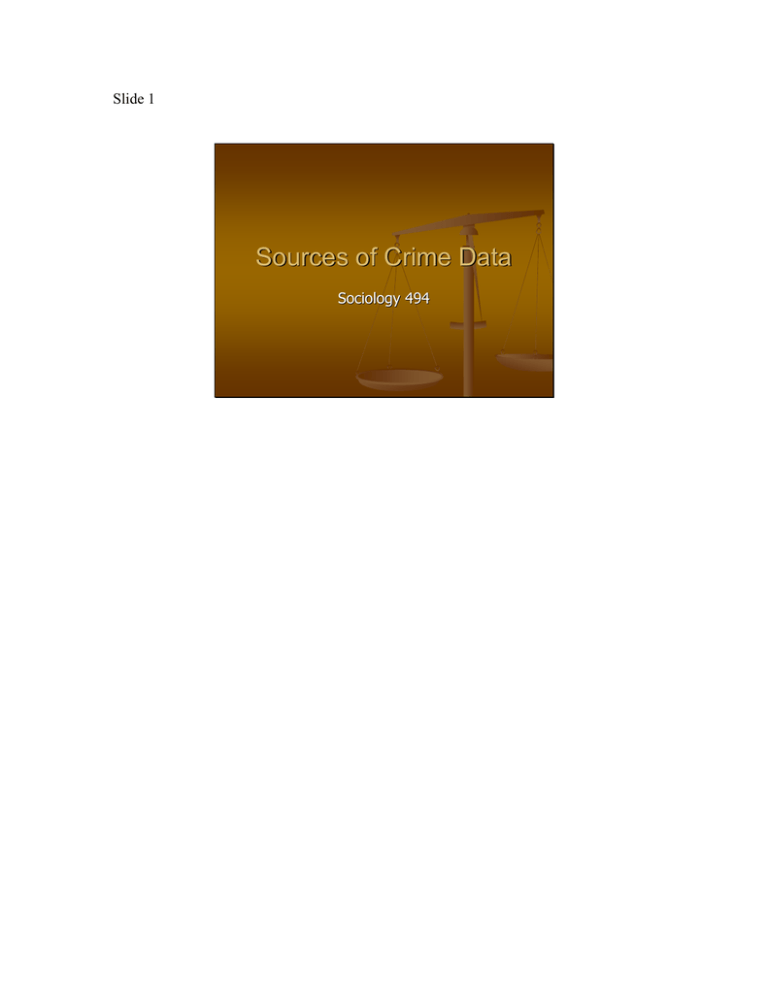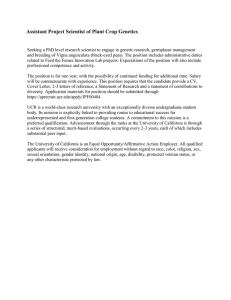
Slide 1
Sources of Crime Data
Sociology 494
Slide 2
Confusion over Crime!
In May 2001, the FBI’s UCR estimates
showed that violent crime had stabilized in
2000 after several years of decline.
At the same time, the NCVS (for 2000)
reported that violent crime was down 15%
from its ’99 level.
HUH?
Slide 3
UCR Vs. NCVS
UCR goes back to 1929
Index Crimes:
Homicide
Rape (females)
Robbery
Aggravated assault
NCVS instituted in 1972
Victimizations:
Theft
Burglary
Motor vehicle theft
Arson
Rape/sexual assault
Robbery
Aggravated assault
Simple assault
Theft
Burglary
Motor vehicle theft
Slide 4
UCR vs. NCVS
UCR – crimes known to law enforcements & reported to the FBI
from 95% of jurisdictions in US.
NCVS – Household survey of people over 12 years of age. Crimes
may or may not have been reported to police.
Since 1972, the NCVS & UCR have corresponded about 60% of the
time in reporting trends of violent offenses.
The two reports have corresponded about 75% of the time for
trends in property offenses.
Slide 5
Crime Against Persons & Property
UCR captures reported crimes against all
persons, businesses, organizations, &
agencies
NCVS excludes those under 12. Does not
collect data on crimes against
organizations or businesses – or on people
who are not US residents.
NCVS measures simple assault – UCR does
not include it in the index crime rate.
Slide 6
Crime Definitions may vary
between the two reporting systems
UCR Index does not measure simple assaults –
the most common violent crime.
UCR Index counts offenses or incidents of crime
rather than victimizations. (One UCR crime may
have a number of victims.)
Victims only show up in NCVS if they appear in
the sample. (Multiple victims may not be in
sample for one reason or another.)
Slide 7
Error in crime stats
UCR is subject to nonnon-reporting error
(incomplete reporting); Illinois has not sent rape
data to UCR since 1985, because the statutory
definition of sex assault didn’t fit UCR criteria.
NCVS reports are subject to sampling and nonnonsampling error (i.e., usually 95% confidence
intervals used).
NCVS tries to deal with series victimizations –
but this may not capture domestic violence
accurately
Slide 8
Back to that weird drop in NCVS
crime rates . . .
Many crimes go unreported to police for a
variety of reasons (embarrassment, fear of
reprisal, lack of confidence in the police,
etc.)
The 19991999-2000 drop in crime resulted
primarily from a 14% point difference
between reported and unreported crimes.
Most of the unreported crimes were
simple assaults.
Week One
Soc. 494
Crime Data
Victimization Data
http://www.ojp.usdoj.gov/bjs/glance/vsx2.htm
http://www.ojp.usdoj.gov/bjs/glance/race.htm
http://www.ojp.usdoj.gov/bjs/glance/vage.htm
http://www.ojp.usdoj.gov/bjs/glance/viort.htm
Incident Reports
Crime Trends (including victim & incident reports)
http://www.ojp.usdoj.gov/bjs/glance.htm#Crime
Incident Reports: Hawaii
http://cpja.ag.state.hi.us/rs/cih/UCRhawaii.htm
ftp://ftp.cpja.ag.state.hi.us/users/crs/pub/semi03.pdf (charts)
Misc. Statistical Reports
http://www.albany.edu/sourcebook/1995/pdf/section3.pdf
http://www.ojp.usdoj.gov/bjs/
Chart showing measures of four types of violent crimes
http://www.ojp.usdoj.gov/bjs/pub/pdf/tcsadnci.pdf



